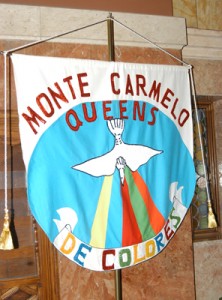 Hundreds of Cursillistas exchanged greetings of “De Colores” as they gathered Nov. 10 to celebrate the 50th anniversary of the Cursillo de Cristiandad movement in the Brooklyn Diocese with Mass and a reception at St. Teresa Church, Woodside.
Hundreds of Cursillistas exchanged greetings of “De Colores” as they gathered Nov. 10 to celebrate the 50th anniversary of the Cursillo de Cristiandad movement in the Brooklyn Diocese with Mass and a reception at St. Teresa Church, Woodside.
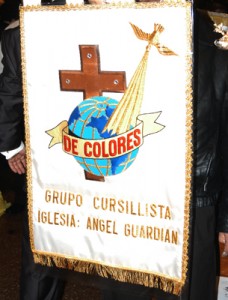
The Cursillo de Cristiandad, or short course of Christianity, is a worldwide lay movement whose members are called to know Christ better and become instruments of evangelization in their homes and communities by embracing the principles of study, piety and action.
Cursilliastas sang “Quiero Decirte Que Si” (I Want to Say Yes) as they processed into Mass carrying banners representing many of the 55 diocesan parishes actively involved in the movement.
“Feliz Aniversario,” announced retired Auxiliary Bishop Guy Sansaricq, who was the main celebrant of the afternoon Mass.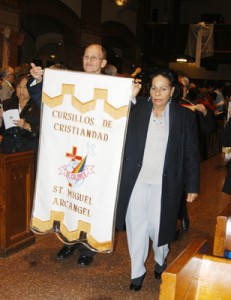
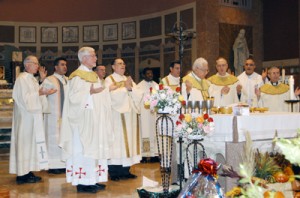 Special concelebrants included Msgr. Perfecto Vazquez, spiritual director of the movement and homilist; Msgr. Steven Ferrari, St. Teresa’s pastor; Msgr. John O’Brien, former head of the Spanish division of the diocesan Migration Office; and Father Pablo Ruani, I.V.E., pastor of St. Michael-St. Malachy, East New York.
Special concelebrants included Msgr. Perfecto Vazquez, spiritual director of the movement and homilist; Msgr. Steven Ferrari, St. Teresa’s pastor; Msgr. John O’Brien, former head of the Spanish division of the diocesan Migration Office; and Father Pablo Ruani, I.V.E., pastor of St. Michael-St. Malachy, East New York.
Deacons Jaime Varela, Jorge Gonzalez and Manuel Barahona, special assistant to Msgr. Vazquez, assisted on the altar.
Among the standing-room-only crowd was Clara Rodriguez from St. Sylvester parish, East New York.
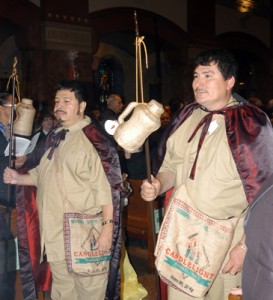 When she lived Cursillo 326 in September, 1978, she said, “I had this encounter with Christ. There I understood who Christ is and who we are and who my neighbor is.”
When she lived Cursillo 326 in September, 1978, she said, “I had this encounter with Christ. There I understood who Christ is and who we are and who my neighbor is.”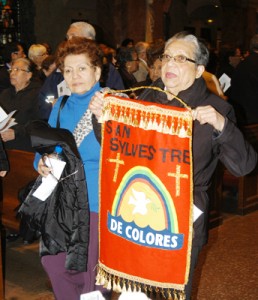
Now she is one of the movement’s leaders, responsible for introducing the Cursillo to local parishes with Spanish-speaking communities.
“We’ve been evangelizing in the diocese for 50 years,” she said, “because we want to bring the Christ we all met in Cursillo to others.”
Deacon Barahona, who lived Cursillo 506, proclaimed the Gospel from St. Matthew. In the passage, Jesus commissions His disciples to go and “make disciples of all nations.”
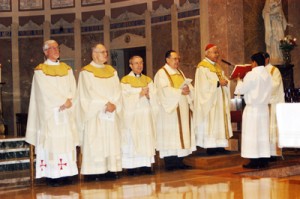 In his homily, Msgr. Vazquez spoke about the movement’s history and meaning as well as its evangelizing mission in the Church today.
In his homily, Msgr. Vazquez spoke about the movement’s history and meaning as well as its evangelizing mission in the Church today. 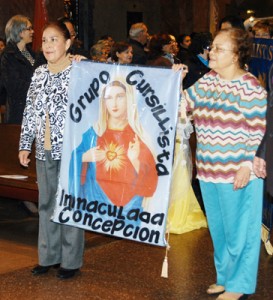 Founded on the island of Majorca, Spain, the movement began in the 1940s in response to Pope Pius XII’s call for Spanish Church leaders to bring the laity back to Christian life and values.The Catholic Action for Youth responded by organizing a pilgrimage for 100,000 youth to Santiago de Compostela. In preparation, weeklong training courses (cursillos) were held for leaders, including Eduardo Bonnin, who soon developed a system of shorter courses, which gave rise to the current three-day Cursillo retreat format.
Founded on the island of Majorca, Spain, the movement began in the 1940s in response to Pope Pius XII’s call for Spanish Church leaders to bring the laity back to Christian life and values.The Catholic Action for Youth responded by organizing a pilgrimage for 100,000 youth to Santiago de Compostela. In preparation, weeklong training courses (cursillos) were held for leaders, including Eduardo Bonnin, who soon developed a system of shorter courses, which gave rise to the current three-day Cursillo retreat format.
The first official Cursillo was held in 1949 and the movement spread to the U.S. in 1957. The Brooklyn Diocese held its first Cursillo Dec. 6-9, 1962, at the Monastery of Suffern in Upstate, N.Y.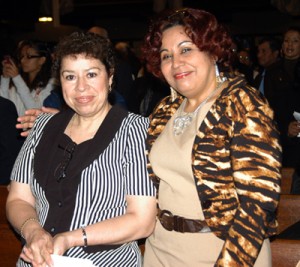
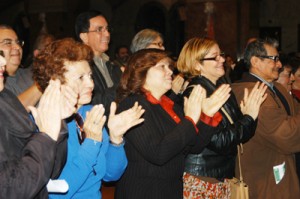 Msgr. Vazquez fondly recalled Casa de Cursillos, the movement’s former retreat house on Congress St., Cobble Hill, which operated from the mid-1960s until last year. Retreats are now held several times annually at the diocesan Jesus of Nazareth Retreat Center in East Flatbush.
Msgr. Vazquez fondly recalled Casa de Cursillos, the movement’s former retreat house on Congress St., Cobble Hill, which operated from the mid-1960s until last year. Retreats are now held several times annually at the diocesan Jesus of Nazareth Retreat Center in East Flatbush.
To date, the diocese has conducted 668 Spanish Cursillo retreats. 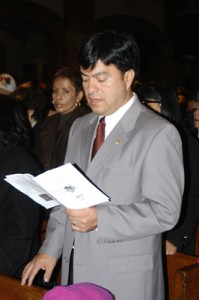 Much more than a retreat consisting of spiritual discussions and personal witness talks, Msgr. Vazquez said: “It’s an encounter with Jesus, but really, it’s a conversion, or renewal, and that renewal has to continue. We have to go out and work for evangelization anywhere and everywhere.”
Much more than a retreat consisting of spiritual discussions and personal witness talks, Msgr. Vazquez said: “It’s an encounter with Jesus, but really, it’s a conversion, or renewal, and that renewal has to continue. We have to go out and work for evangelization anywhere and everywhere.”
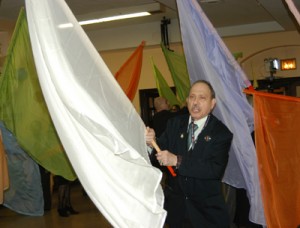 Msgr. Vazquez lived Cursillo 53 in May, 1967, and stayed close to the movement. When the Vincentian priests, who had been directing the movement, left the diocese, Bishop Nicholas DiMarzio appointed Msgr. Vazquez as the new spiritual director in January, 2008.
Msgr. Vazquez lived Cursillo 53 in May, 1967, and stayed close to the movement. When the Vincentian priests, who had been directing the movement, left the diocese, Bishop Nicholas DiMarzio appointed Msgr. Vazquez as the new spiritual director in January, 2008.
“I give myself completely because of the dedication of the lay people,” said Msgr. Vazquez. “It is impossible not to love it.”
Even after the retreat, Cursillistas meet for weekly and monthly group reunions as well as weekly formation sessions, which are held at St. Michael-St. Malachy parish, the home base for the movement since the Casa de Cursillos closed. 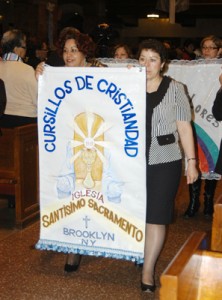
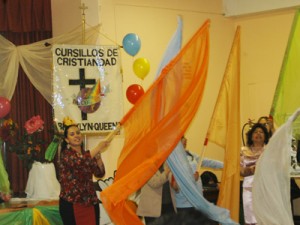 Msgr. Vazquez noted how appropriate it is that the Cursillo should observe its golden jubilee during the Year of Faith since the movement focuses on study, piety and action, or in other words, knowing, living and sharing the faith.
Msgr. Vazquez noted how appropriate it is that the Cursillo should observe its golden jubilee during the Year of Faith since the movement focuses on study, piety and action, or in other words, knowing, living and sharing the faith.
While the current decline in sacramental life and the ongoing economic crisis are challenges facing the movement, Msgr. Vazquez still believes the movement is essential to the new evangelization because it fosters a continual conversion and provides a strong support network for Catholics who strive to live and spread their faith.
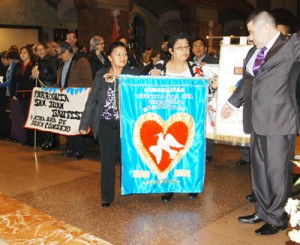 Felix Lajara from St. Martin of Tours, Bushwick, who lived Cursillo 662 last year, agrees.
Felix Lajara from St. Martin of Tours, Bushwick, who lived Cursillo 662 last year, agrees.
“The Cursillo changed my life,” said Lajara, who says it changed the way he sees himself in relation to God and others. 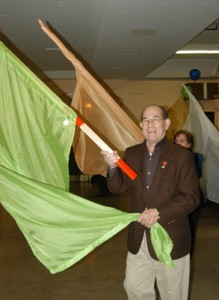
“I go to Mass every Sunday now,” he said, “and I enjoy it. I read my Bible more. I have the formation school every Monday, and we have group (meetings) on Mondays, Tuesdays and Wednesdays.”
In the movement, he says he’s learned the following: “God comes first and after that my neighbor. When I see my neighbor, we laugh, we hug, we cry together. And when I see my neighbor in need, I see God.”
